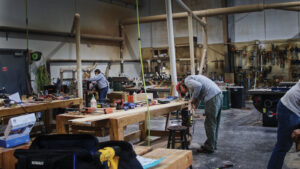The backbone of our family during my formative years was my great aunt, a remarkable woman named Lora Vell, affectionately known as Toad. Hailing from Shannon, Mississippi, born in the year 1923, she was the older sister of my grandmother Willa Mae.
Why the nickname Toad came to be was a mystery that none of us could unravel. Theories ranged from her youthful hopping like a toad frog or perhaps her fondness for catching those amphibians during her Mississippi days. Regardless of the origin of the moniker, one thing was certain: Aunt Toad embarked on a journey to St. Louis from Mississippi during the Great Migration at a young age. After finding her footing and securing work “up north,” she extended her support to her siblings, eventually leading to my own birth in St. Louis.
In those days, agriculture was a distant concept for our family, but Aunt Toad had a green thumb and always tended to a garden in the backyard. Along with the fruit trees, she nurtured a steady supply of greens, okra, and turnips — and man could she cook! Those fresh garden delights found their way into some of the most mouthwatering southern soul food I’ve ever tasted to this day. Regrettably, I didn’t pay much attention to the gardening process back then, and I lacked the wisdom to inquire about it.
Today, though, I find myself pondering such things — how did she acquire her knowledge? How much trial and error did she endure to cultivate a garden abundant enough to feed our large extended family and friends? At Toad’s house, if you came by, you were welcome to eat.
Each summer, Aunt Toad, accompanied by my grandma and whichever of us kids were available, would embark on a road trip in her ever-new Caprice Classic to visit her mother, our tough-as-nails, petite great-grandmother, affectionately called Momma Cora back in Mississippi. The journey seemed forever, but our excitement would skyrocket as we turned onto that dirt road leading to Momma Cora’s house. As we drove past Daddy Steve’s quaint white house at the front of the property, we would finally park the big black Caprice in front of her big white house with its welcoming front porch stretching across the entire facade.
Often, we’d find Aunt Toad, my grandma, and their brother, Uncle John, lounging on the porch in their chairs, eating tomatoes like they were apples, sprinkled with a dash of salt. The Mississippi heat and humidity were relentless, and the house had no air conditioning. Instead, the windows hosted fans that blew during the day, only to be turned off at night while we slept.
Off to the side, there was a small field of corn stalks that Momma Cora would allow us to use to help her feed the backyard chickens. I grew fond of these feathered creatures, cherishing the act of feeding them, but at the back of my mind, I knew that one of them would soon become dinner when I saw Momma Cora’s determined walk toward the backyard.
Witnessing that petite woman firmly grasp a live chicken by the neck and dispatch it remains an unforgettable image etched in my memory. Nor can I erase the sight of a chicken walking around for a few moments with its neck broken. Momma Cora would then take it to the kitchen, deftly de-feather it, butcher it, and fry it up in one of those mighty cast-iron skillets that always adorned her little white stove.
In my younger years, I struggled to enjoy that chicken, feeling a sense of cruelty in eating something I had just fed. However, with the wisdom of hindsight, I now understand that it wasn’t cruelty but rather an essential aspect of the agricultural process — one that undoubtedly shaped my Aunt Toad’s skills.
Oh, how I wish I possessed those same abilities today! I often find myself yearning to plant and maintain my own vegetable garden, just like Aunt Toad did. These were the very skills that kept a modest family from a small town in Mississippi nourished, healthy, and brimming with joy.

Adonica Coleman is the founder of The COMO 411 and owner of A2D Events.










